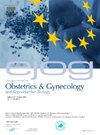富血小板血浆治疗可提高接受冷冻胚胎移植周期的薄子宫内膜患者的子宫内膜容受性:一项前瞻性队列观察研究的结果
IF 1.9
4区 医学
Q2 OBSTETRICS & GYNECOLOGY
European journal of obstetrics, gynecology, and reproductive biology
Pub Date : 2025-10-07
DOI:10.1016/j.ejogrb.2025.114758
引用次数: 0
摘要
目的探讨子宫内灌注自体富血小板血浆(PRP)对薄子宫内膜冷冻胚胎移植的影响。方法于2023年8月1日至2024年7月31日在新德里Akanksha IVF中心进行前瞻性队列观察研究。该研究包括100名40岁以下子宫内膜薄(经阴道超声检查为7毫米)的患者。参与者从月经周期的第2天开始接受激素替代治疗(戊酸雌二醇的顺序增量剂量)。其中70例患者在月经周期的第7、9、11天接受子宫内灌注PRP,其余30例患者未接受此治疗。监测子宫内膜厚度,第14天或子宫内膜厚度超过7 mm时开始使用黄体酮,第6天使用黄体酮进行囊胚移植。妊娠结局评估采用尿妊娠试验或血清β人绒毛膜促性腺激素水平,随后超声确认胎儿生存能力。评估的主要结果是子宫内膜厚度的改善和临床妊娠率。结果宫内灌注PRP组子宫内膜平均厚度显著高于非PRP组(p = 0.032)。PRP组临床妊娠率为35.71%,非PRP组为10% (p = 0.0251)。未见不良反应。结论sprp治疗可显著提高难治性薄内膜患者的子宫内膜容受性,改善妊娠结局。它为在冷冻胚胎移植中面临重复周期取消的患者提供了一种有希望的辅助治疗。本文章由计算机程序翻译,如有差异,请以英文原文为准。
Platelet-rich plasma therapy enhances endometrial receptivity in thin endometrium patients undergoing frozen embryo transfer cycles: results from a prospective cohort observational study
Objective
To evaluate the impact of intrauterine instillation of autologous platelet-rich plasma (PRP) on women with thin endometrium undergoing frozen embryo transfer.
Methods
A prospective cohort observational study was carried out at Akanksha IVF Centre, New Delhi, from 1st August 2023 to 31st July 2024. The study included 100 patients under 40 years with thin endometrium (<7 mm on transvaginal sonography). Participants received hormone replacement therapy (sequential incremental dosage of estradiol valerate) from day 2 of the menstrual cycle. Among them, 70 patients received intrauterine PRP instillation on days 7, 9, and 11 of the cycle, while the remaining 30 patients did not undergo this treatment. Endometrial thickness was monitored, and progesterone was initiated on day 14 or once endometrial thickness surpassed 7 mm, followed by blastocyst transfer on day 6 of progesterone. Pregnancy outcomes were assessed using urine pregnancy tests or serum beta human chorionic gonadotropin levels followed by ultrasound to confirm fetal viability. The main outcomes assessed were improvement in endometrial thickness and clinical pregnancy rate.
Results
The administration of PRP through intrauterine instillation significantly increased mean endometrial thickness in the PRP group compared to the non-PRP group (p = 0.032). The clinical pregnancy rate was 35.71 % in the PRP group versus 10 % in the non-PRP group (p = 0.0251). No adverse reactions were observed.
Conclusions
PRP therapy significantly enhances endometrial receptivity and improves pregnancy outcomes in patients with refractory thin endometrium. It offers a promising adjunctive treatment for patients facing repeated cycle cancellations in frozen embryo transfer.
求助全文
通过发布文献求助,成功后即可免费获取论文全文。
去求助
来源期刊
CiteScore
4.60
自引率
3.80%
发文量
898
审稿时长
8.3 weeks
期刊介绍:
The European Journal of Obstetrics & Gynecology and Reproductive Biology is the leading general clinical journal covering the continent. It publishes peer reviewed original research articles, as well as a wide range of news, book reviews, biographical, historical and educational articles and a lively correspondence section. Fields covered include obstetrics, prenatal diagnosis, maternal-fetal medicine, perinatology, general gynecology, gynecologic oncology, uro-gynecology, reproductive medicine, infertility, reproductive endocrinology, sexual medicine and reproductive ethics. The European Journal of Obstetrics & Gynecology and Reproductive Biology provides a forum for scientific and clinical professional communication in obstetrics and gynecology throughout Europe and the world.

 求助内容:
求助内容: 应助结果提醒方式:
应助结果提醒方式:


